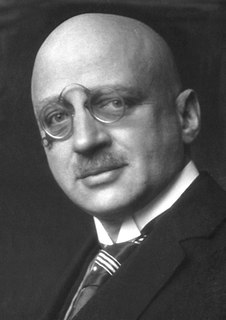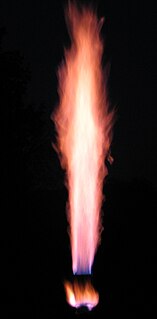
Flatulence is defined in the medical literature as "flatus expelled through the anus" or the "quality or state of being flatulent", which is defined in turn as "marked by or affected with gases generated in the intestine or stomach; likely to cause digestive flatulence". The root of these words is from the Latin flatus – "a blowing, a breaking wind". Flatus is also the medical word for gas generated in the stomach or bowels. Despite these standard definitions, a proportion of intestinal gas may be swallowed environmental air, and hence flatus is not totally generated in the stomach or bowels. The scientific study of this area of medicine is termed flatology.

A fuel cell is an electrochemical cell that converts the chemical energy of a fuel and an oxidizing agent into electricity through a pair of redox reactions. Fuel cells are different from most batteries in requiring a continuous source of fuel and oxygen to sustain the chemical reaction, whereas in a battery the chemical energy usually comes from metals and their ions or oxides that are commonly already present in the battery, except in flow batteries. Fuel cells can produce electricity continuously for as long as fuel and oxygen are supplied.

Hydrogen is the chemical element with the symbol H and atomic number 1. Hydrogen is the lightest element. At standard conditions hydrogen is a gas of diatomic molecules having the formula H2. It is colorless, odorless, non-toxic, and highly combustible. Hydrogen is the most abundant chemical substance in the universe, constituting roughly 75% of all normal matter. Stars such as the Sun are mainly composed of hydrogen in the plasma state. Most of the hydrogen on Earth exists in molecular forms such as water and organic compounds. For the most common isotope of hydrogen (symbol 1H) each atom has one proton, one electron, and no neutrons.

The Haber process, also called the Haber–Bosch process, is an artificial nitrogen fixation process and is the main industrial procedure for the production of ammonia today. It is named after its inventors, the German chemists Fritz Haber and Carl Bosch, who developed it in the first decade of the 20th century. The process converts atmospheric nitrogen (N2) to ammonia (NH3) by a reaction with hydrogen (H2) using a metal catalyst under high temperatures and pressures:

In chemistry and manufacturing, electrolysis is a technique that uses direct electric current (DC) to drive an otherwise non-spontaneous chemical reaction. Electrolysis is commercially important as a stage in the separation of elements from naturally occurring sources such as ores using an electrolytic cell. The voltage that is needed for electrolysis to occur is called the decomposition potential. The word "lysis" means to separate or break, so in terms, electrolysis would mean "breakdown via electricity".

Liquid hydrogen (LH2 or LH2) is the liquid state of the element hydrogen. Hydrogen is found naturally in the molecular H2 form.

Hydrogen sulfide is a chemical compound with the formula H
2S. It is a colorless chalcogen hydride gas with the characteristic foul odor of rotten eggs. It is poisonous, corrosive, and flammable.

A hydrogen vehicle is a type of alternative fuel vehicle that uses hydrogen fuel for motive power. Hydrogen vehicles include hydrogen-fueled space rockets, as well as automobiles and other transportation vehicles. Power is generated by converting the chemical energy of hydrogen to mechanical energy, either by reacting hydrogen with oxygen in a fuel cell to power electric motors or, less commonly, by burning hydrogen in an internal combustion engine.

Syngas, or synthesis gas, is a fuel gas mixture consisting primarily of hydrogen, carbon monoxide, and very often some carbon dioxide. The name comes from its use as intermediates in creating synthetic natural gas (SNG) and for producing ammonia or methanol. Syngas is usually a product of coal gasification and the main application is electricity generation. Syngas is combustible and can be used as a fuel of internal combustion engines. Historically, it has been used as a replacement for gasoline, when gasoline supply has been limited; for example, wood gas was used to power cars in Europe during WWII. However, it has less than half the energy density of natural gas.
A reducing atmosphere is an atmospheric condition in which oxidation is prevented by removal of oxygen and other oxidizing gases or vapours, and which may contain actively reducing gases such as hydrogen, carbon monoxide, and gases such as hydrogen sulfide that would be oxidized by any present oxygen. Although early in its history the Earth had a reducing atmosphere, it now instead has an oxidizing atmosphere with molecular oxygen (dioxygen, O2) as the primary oxidizing agent.
The standard hydrogen electrode, is a redox electrode which forms the basis of the thermodynamic scale of oxidation-reduction potentials. Its absolute electrode potential is estimated to be 4.44 ± 0.02 V at 25 °C, but to form a basis for comparison with all other electroreactions, hydrogen's standard electrode potential (E°) is declared to be zero volts at any temperature. Potentials of any other electrodes are compared with that of the standard hydrogen electrode at the same temperature.

Alternative fuel, known as non-conventional and advanced fuels, are any materials or substances that can be used as fuels, other than conventional fuels like; fossil fuels, as well as nuclear materials such as uranium and thorium, as well as artificial radioisotope fuels that are made in nuclear reactors.
The hydrogen economy is using hydrogen to decarbonize economic sectors which are hard to electrify. In order to phase out fossil fuels and limit climate change, hydrogen can be created from water using renewable sources such as wind and solar, and its combustion only releases water vapor to the atmosphere.
Hydrogen fuel is a zero carbon fuel burned with oxygen; provided it is created in a zero carbon way. It can be used in fuel cells or internal combustion engines. Regarding hydrogen vehicles, hydrogen has begun to be used in commercial fuel cell vehicles, such as passenger cars, and has been used in fuel cell buses for many years. It is also used as a fuel for spacecraft propulsion.
Steam reforming or steam methane reforming is a method for producing syngas (hydrogen and carbon monoxide) by reaction of hydrocarbons with water. Commonly natural gas is the feedstock. The main purpose of this technology is hydrogen production. The reaction is represented by this equilibrium:
Shielding gases are inert or semi-inert gases that are commonly used in several welding processes, most notably gas metal arc welding and gas tungsten arc welding. Their purpose is to protect the weld area from oxygen, and water vapour. Depending on the materials being welded, these atmospheric gases can reduce the quality of the weld or make the welding more difficult. Other arc welding processes use alternative methods of protecting the weld from the atmosphere as well – shielded metal arc welding, for example, uses an electrode covered in a flux that produces carbon dioxide when consumed, a semi-inert gas that is an acceptable shielding gas for welding steel.

Ammonium hydrosulfide is the chemical compound with the formula (NH4)HS.

Electrolysis of water is the process of using electricity to decompose water into oxygen and hydrogen gas by a process called electrolysis. Hydrogen gas released in this way can be used as hydrogen fuel, or remixed with the oxygen to create oxyhydrogen gas, which is used in welding and other applications.
Hydrogen production is the family of industrial methods for generating hydrogen gas. As of 2020, the majority of hydrogen (∼95%) is produced from fossil fuels by steam reforming of natural gas, partial oxidation of methane, and coal gasification. Other methods of hydrogen production include biomass gasification, no CO2 emissions methane pyrolysis, and electrolysis of water. The latter processes, methane pyrolysis as well as water electrolysis can be done directly with any source of electricity, such as solar power.
A lifting gas or lighter than air gas is a gas that has a lower density than normal atmospheric gases and rises above them as a result. It is required for aerostats to create buoyancy, particularly in lighter-than-air aircraft, which include free balloons, moored balloons, and airships. Only certain lighter than air gases are suitable as lifting gases. Dry air has a density of about 1.29 g/L at standard conditions for temperature and pressure (STP) and an average molecular mass of 28.97 g/mol, and so lighter than air gases have a density lower than this.











